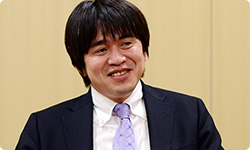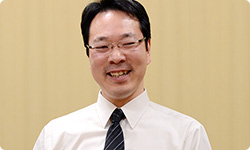5. What We Couldn’t Do with Ocarina of Time
Part of the way through development, one and a half years before release, you had to do modelling and motions not just for Adult Link but for Young Link, too. Koizumi-san, how did you solve that?
We solved it with a simple trick. We realised that by applying a scale of a certain value to Adult Link’s model, we could double-up use of all the same things.
You realised that you could use the motions of Adult Link for Young Link, too.
Yes. We could solve it technologically, so I said, “We can make Young Link,” and gave it my approval.
But moving from Adult Link to Young Link, you couldn’t just use everything without any changes, right?
No. I had to rework Young Link somewhat, so I had to make 1.5 times the animation.
In the end, how many basic motions did you make for Link?
About 500 patterns. Add to that the programming combinations, and there were even more. One reason we were able to put so many patterns in was the Nintendo 64 system’s ROM cartridges.
You were originally developing The Legend of Zelda: Ocarina of Time for the Nintendo 64DD.13 13Nintendo 64DD: A peripheral for the Nintendo 64 system that was released by RANDnetDD. Service began in 1999 and ended in 2001.
Yes. Miyamoto-san said he had some ideas, like leaving behind all of Link’s footprints.
Yeah. (laughs)
At first, we were making it for the Nintendo 64DD. But reading data from the magnetic disks was...
ROM cartridges don’t have moving mechanical parts, so you can retrieve motion data in an instant wherever it is, but with a magnetic disk, it takes time to move certain mechanical parts, so depending on where the data is, it takes time to retrieve it, so you couldn’t make Link move. If there weren’t many movements and you could fit them in the memory, you could read them to memory from the magnetic disk beforehand, but there were 500 patterns.
Right. Koizumi-san said, “I can’t move my Link on the Nintendo 64DD.”
Yeah. But in the end we decided to release it on a ROM cartridge rather than for the Nintendo 64DD. I think some people were disappointed, but some were happy - none more than myself! (laughs)

Because you would be able to move “your Link” however you wanted. (laughs)
Yeah. (laughs)
So Young Link was going to show up. Riding Epona is also a distinct characteristic of The Legend of Zelda: Ocarina of Time. How did the idea for a horse come up?
It just arose all of a sudden.
No, I don’t think it was sudden. Actually, we’d been talking about a horse even during the development for Super Mario 64.
Oh, I didn’t know that.
But it didn’t happen for Super Mario 64. I was certain we would do it for The Legend of Zelda: Ocarina of Time, so I got ready. By the way, Epona was a girl.
Why is she named Epona? Weren’t we calling her Ao at first?
Ao from Aonuma?
No, no. (laughs) Ao is the natural name for a horse.
Huh? (laughs)
I was the one who named her Epona.
Right! (laughs) Koizumi-san named her first. He said, “We’re going to call this horse Epona.” I didn’t even have time to think of a name! (laughs)
Epona is the goddess of horses and fertility in Celtic mythology, so I used that. When you name something, it increases your affection for it, so I worked hard to make her a good horse.
I had Miyamoto-san explain Epona, but at first he only talked about the camera work. He said that when the horse jumped, he wanted to see it from below. And that was all he said! (laughs)
Yeah, that’s right.
He said we should have it jump over a chasm and show the jump from the bottom of that chasm, against the light, so the light would break through.
It’s unusual for Miyamoto-san to make requests regarding such aspects of presentation.
Yes. That was the only time he’s ever said, “I want to see visuals like this, so make it happen.”
Maybe he’s interested in horses.
That’s probably from Western movies. Miyamoto-san really likes country music.
He reflects his personal interests in his work.
Do you mean the scene in which Epona jumps across a broken bridge? There’s also that scene when it escapes the ranch.
Yeah.
There isn’t just one exit from the ranch.
So we had to make a cut scene for each exit.
That’s right... (laughs)

But when she jumped over a barrier, she jumped on her own.
The horse had auto jump, too.
Right.
The reason the horse jumps automatically is Miyamoto-san said that a Legend of Zelda game doesn’t need any difficult actions.
Nonetheless, the Carrot System went in.
Right. Miyamoto-san did that. (laughs)
Miyamoto-san said that just riding around on a horse wouldn’t be very fun game-wise. He wanted to put in some sort of action, so he added carrots. When you crack the whip, a carrot icon disappears, and Epona goes faster, but if you use up all the carrots, you lose the ability to crack the whip for a while and can’t jump over barriers.
Game operation was a little difficult there.
Yes. But isn’t there a contradiction between cracking the whip at just the right timing and not requiring any difficult game operation? (laughs)
Yeah. (laughs)
But Miyamoto-san was the one who put that in. (laughs)
Once you achieve the goal of being able to ride a horse, you might want to try out something further.
That’s why he started saying that if Link was going to ride a horse, he wanted to include mounted archery and one-on-one battle. (laughs) We were able to include the mounted archery, but not the one-on-one battle.
But later you included it in The Legend of Zelda: Twilight Princess .14 14The Legend of Zelda: Twilight Princess: An action-adventure game released for the Wii console and the Nintendo GameCube system in December 2006.
Yeah.
Miyamoto-san is the kind of guy to stick with an idea once he’s thought of it. (laughs)
That’s right. Apart from the horse, ever since The Legend of Zelda: Ocarina of Time, Miyamoto-san has said that he wanted Link to raise his sword over his head.
He said that to me, too. We couldn’t do it on the Nintendo 64 system.
But you can raise the sword in The Legend of Zelda: Skyward Sword, right?
Yes. It uses the Wii MotionPlus technology15, so we’ve finally done it. 15Wii MotionPlus: A peripheral device that attaches to the Wii Remote controller and senses precise gameplay movements.
After 13 years, you’ve fulfilled another wish.
So to Miyamoto-san, all the games in the Legend of Zelda series are connected.